
Each of the following ground-state electron configurations represents one or more of the transition metal ions in Figure 4.12. Identify the ion or ions represented by each.
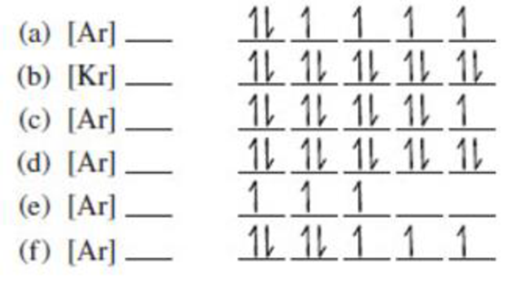
(a)
Interpretation: The ion or ions of transition metals that is represented by the given ground state electronic configuration has to be identified.
Concept Introduction:
- The d-block elements in the periodic table are known as transition metals. When looking at the first series of d-block elements the 4s orbital is filled first before the filling of 3d orbital happens. Therefore, when electron is removed from d-block elements, the two electrons from the “s” orbital is removed first followed by the “d” orbital. This is the reason why many of the transition metals form ions in “+2” state. Two possible oxidation states are there for transition metals namely “+2” and “+3”.
- For simpler representation of ions or atoms, the electronic configuration of the completed octet noble gas configuration is considered and the remaining orbital alone is shown explicitly. The ground-state configuration of the noble gases are given below,
To identify: The transition metal ion or ions that represent the given ground-state electronic configuration.
Answer to Problem 4.85QP
Answer
The transition metal ion found for (a) is
Explanation of Solution
Ground-state electronic configuration of the given ion (a) is,

The atomic ground-state configuration is given in the problem statement. From this we can find that the given ion has an empty 4s orbital and 3d sub-shell that has six electrons.
Identifying the ions as follows,
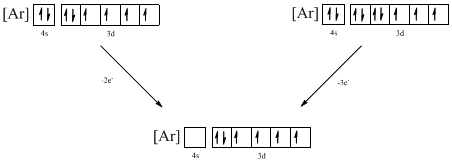
From the configuration given in the problem statement, we can conclude that the ion is formed by removing two electrons from 4s orbital. Another ion can be formed by removing electron from 4s orbital and 3d orbital. Therefore there are two possibility for the ions to have the given electron configuration. It is found to be
(b)
Interpretation: The ion or ions of transition metals that is represented by the given ground state electronic configuration has to be identified.
Concept Introduction:
- The d-block elements in the periodic table are known as transition metals. When looking at the first series of d-block elements the 4s orbital is filled first before the filling of 3d orbital happens. Therefore, when electron is removed from d-block elements, the two electrons from the “s” orbital is removed first followed by the “d” orbital. This is the reason why many of the transition metals form ions in “+2” state. Two possible oxidation states are there for transition metals namely “+2” and “+3”.
- For simpler representation of ions or atoms, the electronic configuration of the completed octet noble gas configuration is considered and the remaining orbital alone is shown explicitly. The ground-state configuration of the noble gases are given below,
To identify: The transition metal ion or ions that represent the given ground-state electronic configuration.
Answer to Problem 4.85QP
Answer
The transition metal ion found for (b) is
Explanation of Solution
Ground-state electronic configuration of the given ion (b) is,

The atomic ground-state configuration is given in the problem statement. From this we can find that the given ion has an empty 5s orbital and 4d sub-shell that has ten electrons.
Identifying the ion as follows,
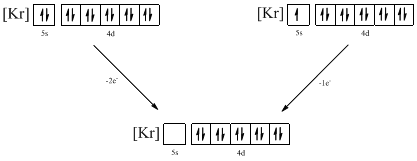
From the configuration given in the problem statement, we can conclude that the ion is formed by removing two electrons from 5s orbital. Another possibility is that the 5s orbital may be singly filled. Therefore, there are two possibility of ions to have the given ground-state electronic configuration. It is found to be
(c)
Interpretation: The ion or ions of transition metals that is represented by the given ground state electronic configuration has to be identified.
Concept Introduction:
- The d-block elements in the periodic table are known as transition metals. When looking at the first series of d-block elements the 4s orbital is filled first before the filling of 3d orbital happens. Therefore, when electron is removed from d-block elements, the two electrons from the “s” orbital is removed first followed by the “d” orbital. This is the reason why many of the transition metals form ions in “+2” state. Two possible oxidation states are there for transition metals namely “+2” and “+3”.
- For simpler representation of ions or atoms, the electronic configuration of the completed octet noble gas configuration is considered and the remaining orbital alone is shown explicitly. The ground-state configuration of the noble gases are given below,
To identify: The transition metal ion or ions that represent the given ground-state electronic configuration.
Answer to Problem 4.85QP
Answer
The transition metal ion found for (c) is
Explanation of Solution
Ground-state electronic configuration of the given ion (c) is,

The atomic ground-state configuration is given in the problem statement. From this we can find that the given ion has an empty 4s orbital and 3d sub-shell that has nine electrons.
Identifying the ion as follows,
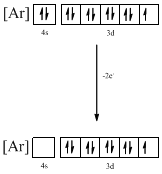
From the configuration given in the problem statement, we can conclude that the ion is formed by removing one electron from 4s orbital and one electron form 3d orbital. The ion that has the given ground-state electronic configuration is found to be
(d)
Interpretation: The ion or ions of transition metals that is represented by the given ground state electronic configuration has to be identified.
Concept Introduction:
- The d-block elements in the periodic table are known as transition metals. When looking at the first series of d-block elements the 4s orbital is filled first before the filling of 3d orbital happens. Therefore, when electron is removed from d-block elements, the two electrons from the “s” orbital is removed first followed by the “d” orbital. This is the reason why many of the transition metals form ions in “+2” state. Two possible oxidation states are there for transition metals namely “+2” and “+3”.
- For simpler representation of ions or atoms, the electronic configuration of the completed octet noble gas configuration is considered and the remaining orbital alone is shown explicitly. The ground-state configuration of the noble gases are given below,
To identify: The transition metal ion or ions that represent the given ground-state electronic configuration.
Answer to Problem 4.85QP
Answer
The transition metal ion found for (d) is
Explanation of Solution
Ground-state electronic configuration of the given ion (d) is,

The atomic ground-state configuration is given in the problem statement. From this we can find that the given ion has an empty 4s orbital and 3d sub-shell that has ten electrons.
Identifying the ion as follows,
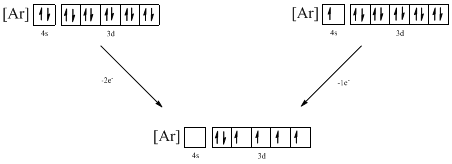
From the configuration given in the problem statement, we can conclude that the ion is formed by removing one electron from 4s orbital. Another possibility is that two electrons can be removed from the 4s orbital. Therefore, there are two possibility of ions to have the given ground-state electronic configuration. It is found to be
(e)
Interpretation: The ion or ions of transition metals that is represented by the given ground state electronic configuration has to be identified.
Concept Introduction:
- The d-block elements in the periodic table are known as transition metals. When looking at the first series of d-block elements the 4s orbital is filled first before the filling of 3d orbital happens. Therefore, when electron is removed from d-block elements, the two electrons from the “s” orbital is removed first followed by the “d” orbital. This is the reason why many of the transition metals form ions in “+2” state. Two possible oxidation states are there for transition metals namely “+2” and “+3”.
- For simpler representation of ions or atoms, the electronic configuration of the completed octet noble gas configuration is considered and the remaining orbital alone is shown explicitly. The ground-state configuration of the noble gases are given below,
To identify: The transition metal ion or ions that represent the given ground-state electronic configuration.
Answer to Problem 4.85QP
Answer
The transition metal ion found for (e) is
Explanation of Solution
Ground-state electronic configuration of the given ion (e) is,

The atomic ground-state configuration is given in the problem statement. From this we can find that the given ion has an empty 4s orbital and 3d sub-shell that has three electrons.
Identifying the ion as follows,
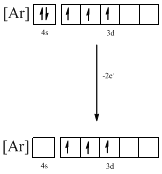
From the configuration given in the problem statement, we can conclude that the ion is formed by removing two electrons from 4s orbital. Therefore, there is only one possibility for the given ground-state electronic configuration. The ion is found to be
(f)
Interpretation: The ion or ions of transition metals that is represented by the given ground state electronic configuration has to be identified.
Concept Introduction:
- The d-block elements in the periodic table are known as transition metals. When looking at the first series of d-block elements the 4s orbital is filled first before the filling of 3d orbital happens. Therefore, when electron is removed from d-block elements, the two electrons from the “s” orbital is removed first followed by the “d” orbital. This is the reason why many of the transition metals form ions in “+2” state. Two possible oxidation states are there for transition metals namely “+2” and “+3”.
- For simpler representation of ions or atoms, the electronic configuration of the completed octet noble gas configuration is considered and the remaining orbital alone is shown explicitly. The ground-state configuration of the noble gases are given below,
To identify: The transition metal ion or ions that represent the given ground-state electronic configuration.
Answer to Problem 4.85QP
Answer
The transition metal ion found for (f) is
Explanation of Solution
Ground-state electronic configuration of the given ion (f) is,

The atomic ground-state configuration is given in the problem statement. From this we can find that the given ion has an empty 4s orbital and 3d sub-shell that has seven electrons.
Identifying the ion as follows,
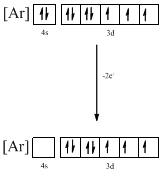
From the configuration given in the problem statement, we can conclude that the ion is formed by removing two electrons from 4s orbital. Therefore, there is only one possibility for the given ground-state electronic configuration. The ion is found to be
Want to see more full solutions like this?
Chapter 4 Solutions
Chemistry: Atoms First
- In an electrolytic cell, indicate the formula that relates E0 to the temperature T.arrow_forward-- 14:33 A Candidate Identification docs.google.com 11. Compound A can transform into compound B through an organic reaction. From the structures below, mark the correct one: HO A تھے۔ די HO B ○ A) Compounds A and B are isomers. B) Both have the same number of chiral carbons. C) Compound A underwent an addition reaction of Cl2 and H2O to form compound B. D) Compound A underwent a substitution reaction forming the intermediate chlorohydrin to obtain compound B. E) Compound A underwent an addition reaction of Cl2 forming the chloronium ion and then added methanol to obtain compound B. 60arrow_forward-- 14:40 A Candidate Identification docs.google.com 13. The compound 1-bromo-hex-2-ene reacts with methanol to form two products. About this reaction, mark the correct statement: OCH3 CH3OH Br OCH3 + + HBr A B A) The two products formed will have the same percentage of formation. B) Product B will be formed by SN1 substitution reaction with the formation of an allylic carbocation. C) Product A will be formed by SN1 substitution reaction with the formation of a more stable carbocation than product B. D) Product A will be formed by an SN2 substitution reaction occurring in two stages, the first with slow kinetics and the second with fast kinetics. E) The two compounds were obtained by addition reaction, with compound B having the highest percentage of formation. 57arrow_forward
- -- ☑ 14:30 A Candidate Identification docs.google.com 10. Amoxicillin (figure X) is one of the most widely used antibiotics in the penicillin family. The discovery and synthesis of these antibiotics in the 20th century made the treatment of infections that were previously fatal routine. About amoxicillin, mark the correct one: HO NH2 H S -N. HO Figura X. Amoxicilina A) It has the organic functions amide, ester, phenol and amine. B) It has four chiral carbons and 8 stereoisomers. C) The substitution of the aromatic ring is of the ortho-meta type. D) If amoxicillin reacts with an alcohol it can form an ester. E) The structure has two tertiary amides. 62arrow_forwardThe environmental police of a Brazilian state received a report of contamination of a river by inorganic arsenic, due to the excessive use of pesticides on a plantation on the riverbanks. Arsenic (As) is extremely toxic in its many forms and oxidation states. In nature, especially in groundwater, it is found in the form of arsenate (AsO ₄ ³ ⁻ ), which can be electrochemically reduced to As ⁰ and collected at the cathode of a coulometric cell. In this case, Potentiostatic Coulometry (at 25°C) was performed in an alkaline medium (pH = 7.5 throughout the analysis) to quantify the species. What potential (E) should have been selected/applied to perform the analysis, considering that this is an exhaustive electrolysis technique (until 99.99% of all AsO ₄ ³ ⁻ has been reduced to As ⁰ at the electrode, or n( final) = 0.01% n( initial )) and that the concentration of AsO ₄ ³ ⁻ found in the initial sample was 0.15 mmol/L ? Data: AsO ₄ 3 ⁻ (aq) + 2 H ₂ O ( l ) + 2 e ⁻ → A s O ₂ ⁻ ( a…arrow_forward-- 14:17 15. Water-soluble proteins are denatured when there is a change in the pH of the environment in which they are found. This occurs due to the protonation and deprotonation of functional groups present in their structure. Choose the option that indicates the chemical bonds modified by pH in the protein represented in the following figure. E CH2 C-OH CH2 H₂C H₁C CH CH3 CH3 CH CH₂-S-S-CH₂- 910 H B -CH2-CH2-CH2-CH₂-NH3* −0—C—CH₂- ○ A) A, C e D. • В) Вес ○ C) DeE ○ D) B, De E ○ E) A, B e C 68arrow_forward
- Suppose sodium sulfate has been gradually added to 100 mL of a solution containing calcium ions and strontium ions, both at 0.15 mol/L. Indicate the alternative that presents the percentage of strontium ions that will have precipitated when the calcium sulfate begins to precipitate. Data: Kps of calcium sulfate: 2.4x10 ⁻ ⁵; Kps of strontium sulfate: 3.2x10 ⁻ ⁷ A) 20,2 % B) 36,6 % C) 62,9 % D) 87,5 % E) 98.7%arrow_forward14:43 A Candidate Identification docs.google.com 14. The following diagrams represent hypothetical membrane structures with their components numbered from 1 to 6. Based on the figures and your knowledge of biological membranes, select the correct alternative. | 3 5 || 人 2 500000 6 A) Structures 1, 3, 5, 2 and 4 are present in a constantly fluid arrangement that allows the selectivity of the movement ○ of molecules. Structure 4, present integrally or peripherally, is responsible for this selection, while the quantity of 6 regulates the fluidity. B) The membranes isolate the cell from the environment, but allow the passage of water-soluble molecules thanks to the presence of 2 and 3. The membrane in scheme is more fluid than that in 55arrow_forward12. Mark the correct statement about reactions a and b : a. Br + -OH Br b. + Br H₂O + Br -OH + H₂O A) The reactions are elimination reactions, with reaction "a" being of type E2 and reaction "b" being of type E1. B) Reaction "a" is an E2 type elimination occurring in one step and reaction "b" is an SN1 type substitution. C) Both reactions can result in the formation of carbocation, but in reaction "b" the most stable carbocation will be formed. D) Both reactions occur at the same rate ○ and have the same number of reaction steps. E) Reaction "b" is an E2 type elimination occurring in two steps and reaction "a" is an SN2 type substitution.arrow_forward
- Chloroform, long used as an anesthetic and now considered carcinogenic, has a heat of vaporization of 31.4 kJ/mol. During vaporization, its entropy increases by 94.2 J/mol.K. Therefore, select the alternative that indicates the temperature, in degrees Celsius, at which chloroform begins to boil under a pressure of 1 atm. A) 28 B) 40 C) 52 D) 60 E) 72arrow_forwardIf we assume a system with an anodic overpotential, the variation of n as a function of current density: 1. at low fields is linear 2. at higher fields, it follows Tafel's law Obtain the range of current densities for which the overpotential has the same value when calculated for 1 and 2 cases (maximum relative difference of 5% compared to the behavior for higher fields). To which overpotential range does this correspond? Data: i = 1.5 mA cm², T = 300°C, B = 0.64, R = 8.314 J K1 mol-1 and F = 96485 C mol-1.arrow_forwardAnswer by equation pleasearrow_forward
 General Chemistry - Standalone book (MindTap Cour...ChemistryISBN:9781305580343Author:Steven D. Gammon, Ebbing, Darrell Ebbing, Steven D., Darrell; Gammon, Darrell Ebbing; Steven D. Gammon, Darrell D.; Gammon, Ebbing; Steven D. Gammon; DarrellPublisher:Cengage Learning
General Chemistry - Standalone book (MindTap Cour...ChemistryISBN:9781305580343Author:Steven D. Gammon, Ebbing, Darrell Ebbing, Steven D., Darrell; Gammon, Darrell Ebbing; Steven D. Gammon, Darrell D.; Gammon, Ebbing; Steven D. Gammon; DarrellPublisher:Cengage Learning Living By Chemistry: First Edition TextbookChemistryISBN:9781559539418Author:Angelica StacyPublisher:MAC HIGHER
Living By Chemistry: First Edition TextbookChemistryISBN:9781559539418Author:Angelica StacyPublisher:MAC HIGHER Chemistry & Chemical ReactivityChemistryISBN:9781133949640Author:John C. Kotz, Paul M. Treichel, John Townsend, David TreichelPublisher:Cengage Learning
Chemistry & Chemical ReactivityChemistryISBN:9781133949640Author:John C. Kotz, Paul M. Treichel, John Townsend, David TreichelPublisher:Cengage Learning Chemistry & Chemical ReactivityChemistryISBN:9781337399074Author:John C. Kotz, Paul M. Treichel, John Townsend, David TreichelPublisher:Cengage Learning
Chemistry & Chemical ReactivityChemistryISBN:9781337399074Author:John C. Kotz, Paul M. Treichel, John Townsend, David TreichelPublisher:Cengage Learning Chemistry: Principles and PracticeChemistryISBN:9780534420123Author:Daniel L. Reger, Scott R. Goode, David W. Ball, Edward MercerPublisher:Cengage Learning
Chemistry: Principles and PracticeChemistryISBN:9780534420123Author:Daniel L. Reger, Scott R. Goode, David W. Ball, Edward MercerPublisher:Cengage Learning World of Chemistry, 3rd editionChemistryISBN:9781133109655Author:Steven S. Zumdahl, Susan L. Zumdahl, Donald J. DeCostePublisher:Brooks / Cole / Cengage Learning
World of Chemistry, 3rd editionChemistryISBN:9781133109655Author:Steven S. Zumdahl, Susan L. Zumdahl, Donald J. DeCostePublisher:Brooks / Cole / Cengage Learning





